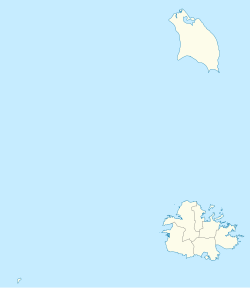User:CROIX/parhamrewrite
Parham | |
|---|---|
Town | |
| Parham Town | |
| Coordinates: 17°06′N 61°46′W / 17.100°N 61.767°W | |
| Country | Antigua and Barbuda |
| Island | Antigua |
| Civil parish | Saint Peter Parish (capital) |
| Government | |
| • Representative | Asot Michael |
| Area | |
| • Town | 1.99 km2 (0.77 sq mi) |
| Population (2011) | |
| • Town | 1,307 |
| • Metro | 3,499 |
| Demonym | Parhamite |
| Time zone | UTC-4 (AST) |
| Website | parhamtown |
Parham Town, often called Parham, is the capital of Saint Peter, the largest city in Saint Peter, and the fourteenth largest city in Antigua and Barbuda. Parham had a population of 1,307 in 2011,[1] distributed over 1.99 square kilometres.[2] Parham is similar in population to Potters Village, the thirteenth largest city in Antigua and Barbuda, and Bendals, the fifteenth largest city. Parham is situated on the shore of Parham Harbour,[3] one of the most important harbors in the country enclosed by the Parham Peninsula and Long Island. Parham comprises of four main neighbourhoods, being Lovers Lane, Parham Market, Byam Wharf, and the School neighborhood.[2] If the Saint Peter portion of All Saints, home to 1,954 people extending across three parishes, is considered a seperate city, Parham would be considered the second largest city of Saint Peter.[4] The major division of Parham, the town's metropolitan area, stretching over the eastern portion of the parish, had a 2011 population of 3,499 people.[5]
Etymology[edit]
The town was given its name in 1675 when a British naval officer by the name of Lord Willoughby de Parham arrived from England with a patent from King Charles II, allowing him to designate Parham as one of the six trading towns in colonial Antigua while also establishing it as the capital of the colony.[3]
History[edit]
Parham served as a significant trading port for the importing of slaves from West Africa and the sale of rum and sugar to England during the colonial era. The agricultural products of the parishes of St. Peter, St. Phillip, and St. George were sold at Parham Harbour.[3] Around 1750, the Parham sugar mill was divided into two separate enterprises, each with its own windmill and boiling house.[6] As a result of the St. Peter's Anglican Parish Church's construction in 1840,[7] Parham would not have seen its heyday and peak population until the middle of the nineteenth century, during the height of the Industrial Revolution and the early days of freedom. Along with the Parham Anglican Rectory, the Parham Anglican Primary School was also built at that time. The Antigua Almanac, a newspaper from the 19th century, claimed that the people these initiatives drew would have turned the town of Parham into the island's capital once more.[3] When sugar prices collapsed in the early to mid-20th century, the vast majority of English sugar planters departed the island, and the descendants of freed slaves from the nearby sugar plantations are likely to have moved into Parham. They maintained the town's existence as a flourishing commercial hub by engaging in trades including fishing, farming, carpentry, and masonry.[3] Massive emigration caused by the collapse of the sugar industry in the 1960s and 1970s led to a population loss in Parham that has not been replaced or recovered from to this day. Agriculture and fishing continue to be the mainstays of the neighborhood economy.[3]
Geography[edit]
Parham is subdivided into six enumeration districts, Lovers Lane, Parham Market, Byams Wharf, Parham School #1, Parham School #2, and Parham School #3.[2] The centre of Parham is located in the Parham Market neighborhood, and is home to four of Parham's 39 business owners.[8][9]
Lovers Lane[edit]
Lovers Lane (ED 50700) is 0.39 km2 and is home to 225 people, with 78.64% of its population being born in Antigua and Barbuda, 6.36% in Guyana, and 5.00% in Dominica, with the remainder of the population mostly being born in other Caribbean countries.[10] The largest religious denomination in the neighbourhood is Anglicanism, with the neighbourhood also having a significant Weslyan Holiness population.[11] 83.64% of the population is African descendant, 0.91% is white, 0.45% is East Indian, 13.18% is other Mixed, 0.45% is Hispanic, 0.45% is some other ethnicity, and 0.91% didn't know or didn't state their ethnicity.[12] Most housing units have metal roofs,[13] and a plurality of housing units have wooden outer walls, with a significant portion having concrete outer walls.[14]
Parham-Market[edit]
Byams Wharf[edit]
Parham-School[edit]
Demographics[edit]
Health[edit]
Economy[edit]
Housing[edit]
Education[edit]
Government and politics[edit]
See also[edit]
References[edit]
External links[edit]
- ^ "Wayback Machine" (PDF). web.archive.org. Retrieved 2023-08-16.
- ^ a b c "Enumeration District Boundaries for the 2021 Census". nri.environment.gov.ag. Retrieved 2023-08-16.
- ^ a b c d e f "History". Parham Alliance Beautification and Revitalization Organization. Retrieved 2023-08-16.
- ^ "Wayback Machine" (PDF). web.archive.org. Retrieved 2023-08-16.
- ^ "Wayback Machine" (PDF). web.archive.org. Retrieved 2023-08-16.
- ^ "Parham New Works – Antigua Sugar Mills". Retrieved 2023-08-16.
- ^ "Parham Hill – Antigua Sugar Mills". Retrieved 2023-08-16.
- ^ "Wayback Machine" (PDF). web.archive.org. Retrieved 2023-08-16.
- ^ "Wayback Machine" (PDF). web.archive.org. Retrieved 2023-08-16.
- ^ "Wayback Machine" (PDF). web.archive.org. Retrieved 2023-08-16.
- ^ "Wayback Machine" (PDF). web.archive.org. Retrieved 2023-08-16.
- ^ "Wayback Machine" (PDF). web.archive.org. Retrieved 2023-08-16.
- ^ "Wayback Machine" (PDF). web.archive.org. Retrieved 2023-08-16.
- ^ "Wayback Machine" (PDF). web.archive.org. Retrieved 2023-08-16.

